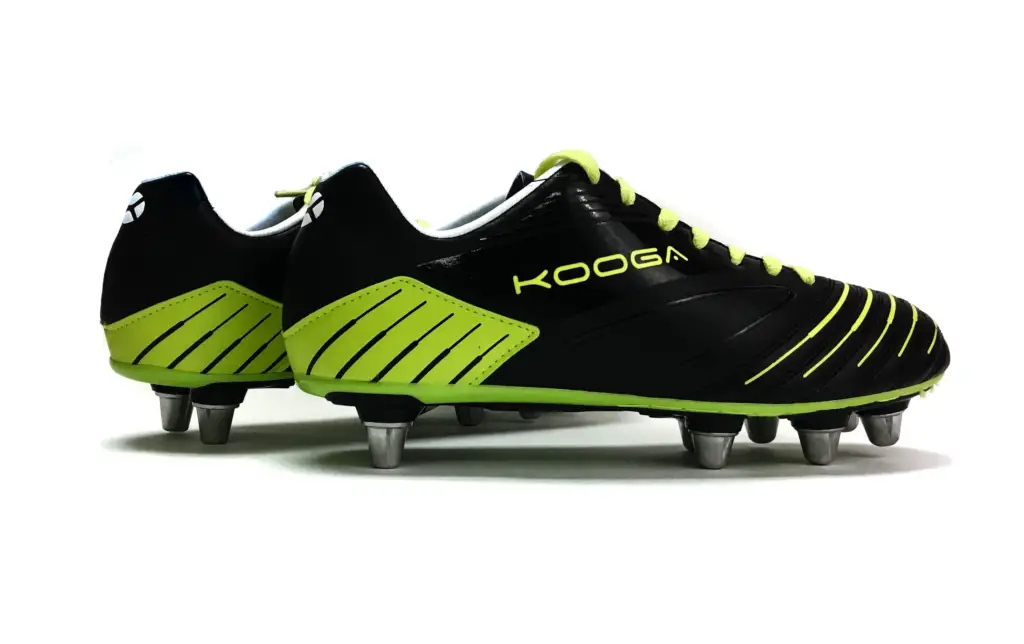Rugby is a sport that demands agility, power, and precision, and the right pair of rugby boots can make all the difference on the field. For new fans or players, understanding the intricacies of rugby boots can be daunting. This comprehensive guide will explain everything you need to know about rugby boots, from their features to how to choose the perfect pair.

Why Rugby Boots Are Important
Rugby boots are designed specifically to handle the unique demands of the game. They provide:
- Grip and Traction: Rugby involves quick changes in direction and high-intensity scrummaging. Boots with studs ensure players maintain stability and grip on the field.
- Support: Proper ankle and arch support help prevent injuries and improve performance.
- Durability: Rugby boots are built to withstand the physical nature of the sport, including heavy impacts and tough playing conditions.
Key Features of Rugby Boots
- Studs
- Soft Ground Studs: Ideal for wet, muddy conditions. These are longer and provide maximum grip.
- Firm Ground Studs: Shorter studs suited for dry or hard pitches.
- Hybrid Studs: A combination of soft and firm ground studs for versatility.
- Cut and Style
- Low-Cut Boots: Offer greater agility and freedom of movement, ideal for backs who need speed.
- Mid-Cut Boots: Provide moderate ankle support and are favored by versatile players.
- High-Cut Boots: Deliver maximum ankle support, preferred by forwards who engage in scrums and rucks.
- Material
- Leather: Offers superior comfort, flexibility, and durability but requires regular maintenance.
- Synthetic: Lightweight and water-resistant, making it a popular choice for modern players.
- Weight
- Lightweight boots enhance speed and agility, while heavier boots provide stability and power for physical play.
Types of Rugby Boots by Position
Rugby positions can be broadly divided into forwards and backs, and each group has specific boot requirements:
- Forwards
- Need boots with high ankle support and sturdy construction to handle scrummaging and rucking.
- Prefer boots with longer studs for better traction in physical contests.
- Backs
- Require lightweight, low-cut boots for speed and agility.
- Favor boots with shorter studs for quick changes in direction and acceleration.
How to Choose the Right Rugby Boots
- Understand Your Position
- Determine your playing position and style to identify the most suitable boot type.
- Consider the Playing Surface
- Analyze the typical conditions of the pitches you’ll play on (soft ground, firm ground, or artificial turf).
- Get the Right Fit
- Ensure a snug fit to avoid blisters and discomfort. Boots that are too loose or tight can impact performance and cause injuries.
- Budget
- Rugby boots are available in various price ranges. While premium boots offer advanced features, there are budget-friendly options that still provide good performance.
- Brand Preferences
- Popular brands like Adidas, Canterbury, and Gilbert offer a wide range of rugby boots catering to different needs.
Maintaining Your Rugby Boots
Proper care can extend the lifespan of your boots and maintain their performance. Here’s how to take care of them:
- Clean Regularly
- Remove mud and dirt after every game using a soft brush and warm water.
- Dry Naturally
- Avoid placing boots near direct heat sources. Instead, stuff them with newspaper to absorb moisture and maintain their shape.
- Check Studs
- Inspect studs regularly for wear and replace them as needed to ensure optimal grip.
- Store Properly
- Keep your boots in a cool, dry place and use a boot bag for added protection.
Popular Rugby Boot Brands and Models
- Adidas
- Known for innovative designs and high-quality materials.
- Popular models: Adidas Kakari (forwards) and Adidas Predator Malice (backs).
- Canterbury
- Specializes in rugby-specific gear with a focus on durability.
- Popular models: Canterbury Phoenix (versatile) and Canterbury Stampede (forwards).
- Gilbert
- Offers reliable and affordable rugby boots.
- Popular models: Gilbert Sidestep and Gilbert Kaizen.
- Puma
- Combines style with performance, appealing to modern players.
- Popular models: Puma Future and Puma King.
Common Mistakes When Choosing Rugby Boots
- Prioritizing Style Over Functionality
- While flashy boots may look good, they’re not always the best choice for your needs.
- Ignoring Fit
- Comfort and fit should be your top priorities to prevent discomfort and injuries.
- Using the Wrong Studs for the Surface
- Mismatched studs can lead to poor performance and even accidents on the field.
- Neglecting Maintenance
- Failing to care for your boots can reduce their lifespan and performance.
FAQs About Rugby Boots
- Can I use football boots for rugby?
- While it’s possible, rugby boots are specifically designed for the demands of the game, offering better support and durability.
- Do I need different boots for different positions?
- Yes, your position influences the type of boots you should choose, especially regarding stud length and ankle support.
- How often should I replace my rugby boots?
- Depending on usage and care, rugby boots typically last one to two seasons.
- What’s the difference between metal and plastic studs?
- Metal studs provide better grip on soft ground, while plastic studs are suitable for firm or artificial surfaces.
Conclusion
Rugby boots are more than just footwear; they’re an essential tool that impacts your performance, safety, and enjoyment of the game. By understanding their features, types, and care requirements, new fans and players can make informed decisions and fully embrace the rugby experience.
Whether you’re a forward looking for stability or a back chasing speed, the right pair of rugby boots can elevate your game and keep you at the top of your performance. So lace up, hit the field, and enjoy the thrill of rugby with confidence!
